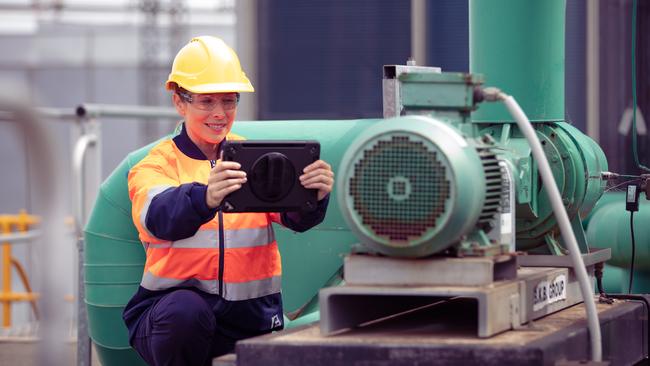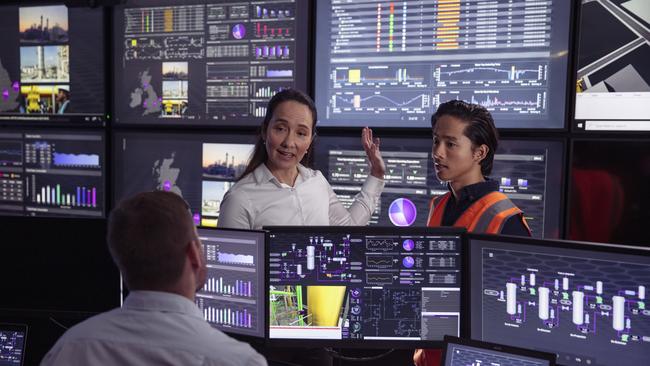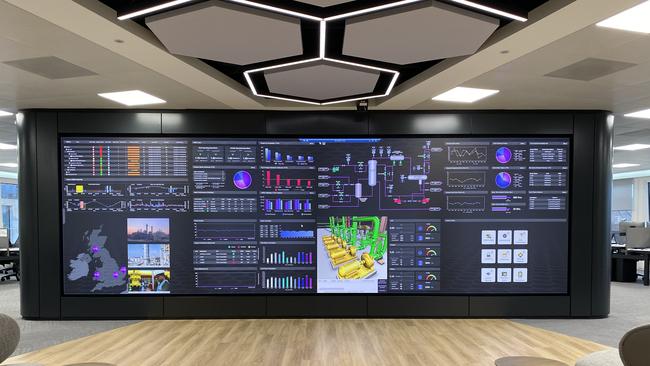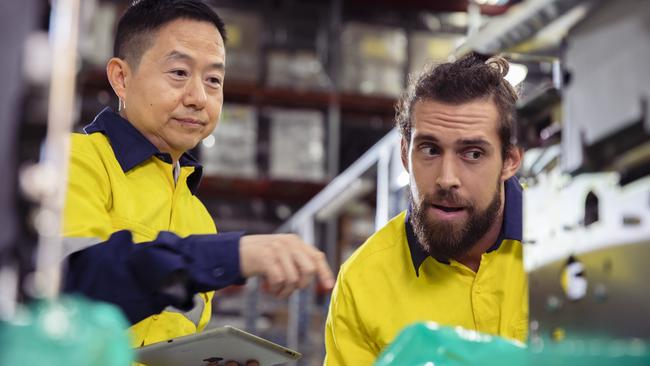The secret software powering green transition at our biggest firms
For 50 years it’s been a silent partner of our miners and energy producers, but this software firm has plans to expand as the race to go green pushes companies to use tech solutions.

For 50 years it’s been content to be the silent partner of some of our biggest firms, but software maker Aveva now has ambitions to grab more market share as companies race to find tech solutions to power green transition.
With 200 staff and two research and development labs in Australia, UK-headquartered AVEVA is responsible for some of the highly-technical software behind the scenes of new industries like solar batteries, green hydrogen as well as legacy ones in oil and gas, water and pharmaceuticals.
AVEVA vice-president of Pacific region Alexey Lebedev, who is based in Brisbane, says some of its core software was invented here and there is a huge opportunity now for it to leverage the transition inside Australia’s big miners and energy clients across the globe.
Since arriving to take over local operations in April last year, he has taken to inviting the likes of Rio Tinto and AGL staff to meet in the local AVEVA office, as not many of them even realised how many of its products its own businesses were already using and how some were on the cutting edge of the digital revolution.

Globally AVEVA has 20,000 clients in 100 countries including Pfizer, Kellogg’s, BP, Toyota and ExxonMobil, but has its eye on expanding into smaller firms across manufacturing, smart cities and green power.
Apart from Rio Tinto and AGL in Australia Aveva’s software is also used by Fortescue Future Industries (FFI), Talison Lithium, Newcrest Mining, Energy Queensland and TasWater to enable everything from real-time monitoring of turbines, automatically predicting stoppages or spills before they happen or allowing engineers to see on a screen what used to be housed in hundreds of pages of paper manuals.
Last year it announced a partnership with FFI to use hybrid cloud software to gather and visualise data across its green hydrogen operations.
“For many customers that come for industry specific products...when we show them the entire holistic picture and how they can evolve, they honestly didn’t know,” Lebedev said.
“It’s about how can we bring global experience to Australia. There is a metal mining focus here, infrastructure and solar too. We want to expand from those.
“At the same time many global companies, if they have a presence in Australia, want to test or have first stage projects in Australia because operationally they are standalone projects in many aspects.”
Digital twins and AI
AVEVA says its software at FFI lays the foundation for a complete operational ‘digital twin’ of any future green hydrogen operation.
Essentially a computer simulation of a real-life plant, a digital twin takes huge amounts of information, from real-time data and engineering drawings of the building or assets like turbine, so staff get a digital view of a real plant.
Once just a dream, with tech advances many companies are now seeing it as a reality on the horizon.

“Hydrogen is a growing opportunity,” Lebedev said
“FFI is right now building on Gibson Island, so they are right now in the engineering phase, that will be the first.”
AVEVA’s growth ambitions in Australia also coincide with heavy industrials being required to capture and report on emissions and sustainability goals across huge amounts of data.
Add in an AI frenzy that enthusiasts see as a way to unburden highly-trained staff from menial tasks.
Also, as many big plants age, staff who often set them up or have decades of experience are coming to the end of their career, with a huge transfer of bespoke knowledge about to be needed.
At the Aveva World showcase in San Francisco at the end of October, the firm unveiled a fully-integrated, hybrid cloud solution that enables industries to turn physical sites into agile digital insights, allowing staff to collaborate on shared data whether they are in the head office, in the plant or operating in the field.

It also showcased how open AI might end up being used to find faults, check manuals, order repairs and go back decades into old maintenance records within seconds.
That’s handy if the head operator has just retired after 40 years and taken all the quirky fixes used to maintain niche equipment with them.
Aveva senior vice president and head of Asia Pacific Emon Zaman said Australia was well positioned to lead the world in transition.
“Australia potentially has a leadership position it can take around hydrogen as our solutions get used more and more by companies like FFI,” he said.
“Our goal would be to leverage that, even have enhancements in these industry solutions, that we can then take to market beyond Australia.
“That’s the goal for us and that’s why we have this presence of R&D in Australia.”
New ways for Rio
At Rio Tinto, the push for digital transformation is about moving away from having “$40bn projects being delivered using 2D drawings”, as its digital project delivery manager Paul Rushton explained.
Rushton is on the vanguard at Rio where he sees huge opportunity and is hoping to convince more sites of what he calls a ‘digital thread’.
“We take 200 legacy drawings, scrape the data off them and put that into the portal,” he said.
“When we finish the design, with the 3D model and electrical drawings, they are all authored in data base tool. You get the same drawings, so you hand over a digital version of the physical plant instead of it being on 2D drawings.
“You can click on it and it tells you the data behind it. It can look in other systems to find maintenance records, spare inventory, also what the throughput is on an asset. It can link to (another Aveva product) tells you the temperature or well speed in real time.”

“It’s not just saving operators time - one hour per person per shift, that would pay for itself.
“Where the real value is, is if we have that information in a timely way problems or safety issues wouldn’t have happened.
“The guy wouldn’t have worked on a live pump or isolated the correct pump if he had the right information, for example.
“I want to get line of sight between the digital asset and the real savings in terms of increased productivity and decreased down time and plant outages.”
Talison Lithium in Western Australia, the largest global supplier of lithium, is another customer using AVEVA products to transform operations at its Greenbushes mines.
Over the years Talison plants had been upgraded and expanded to increase production as lithium demand grew. It contacted Aveva as part of a plant modernization initiative, to streamline operating processes and reduce production losses.
This was driven by an increasingly competitive lithium market globally and the need to manage information from an ageing workforce about to retire.
The writer travelled courtesy of AVEVA to its showcase event in San Francisco in October.





To join the conversation, please log in. Don't have an account? Register
Join the conversation, you are commenting as Logout